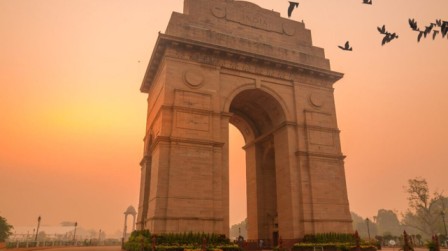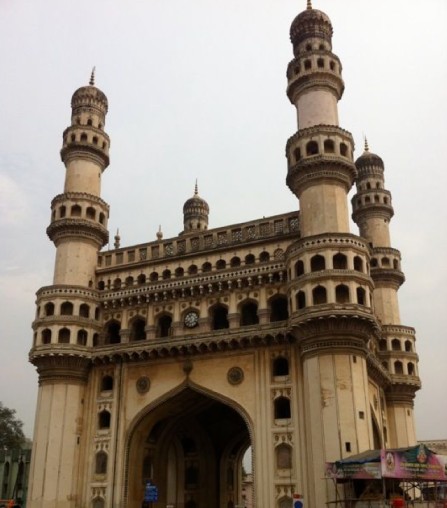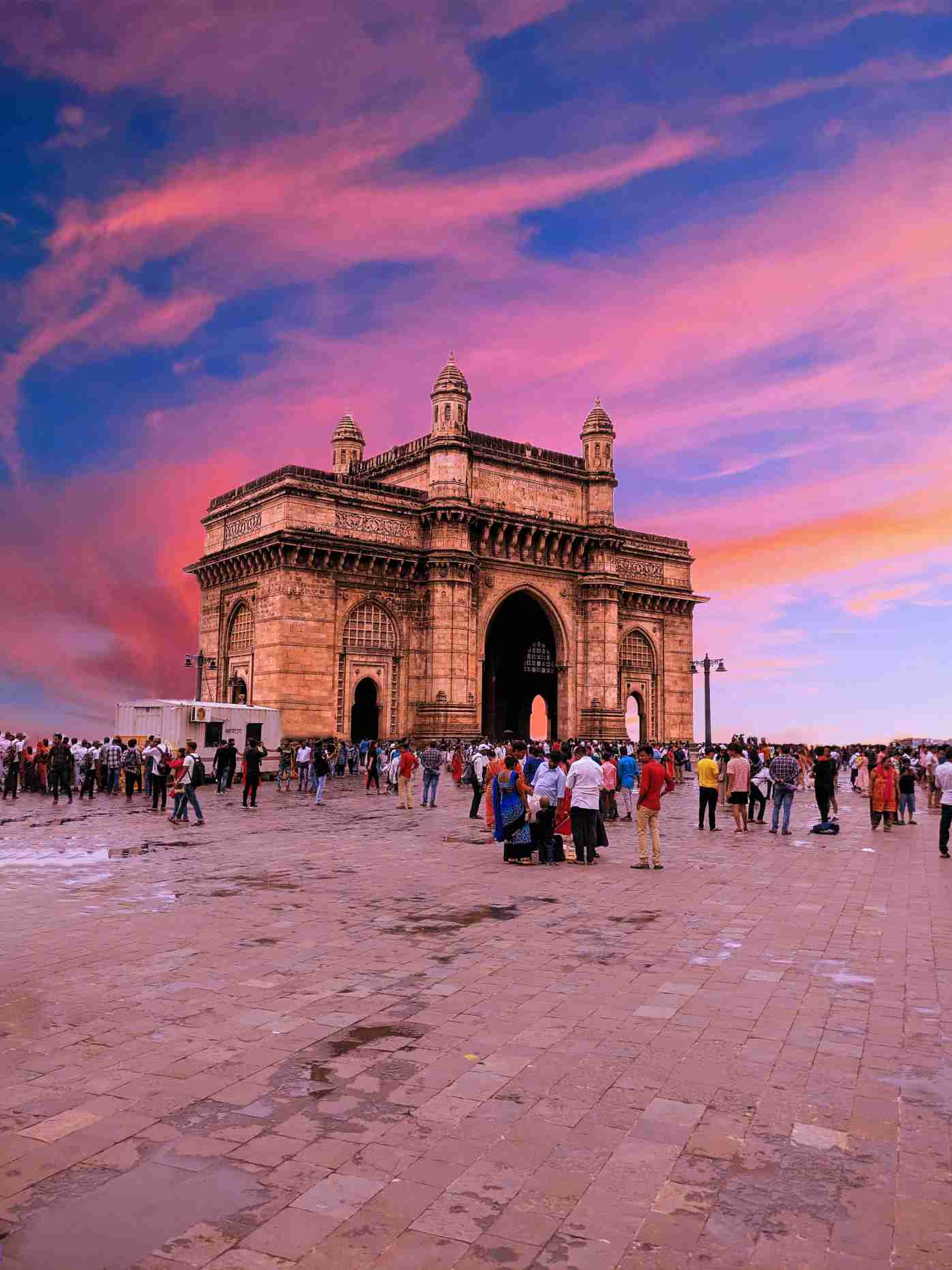The Walled City – Agra Fort
Agra has been a place where you can witness many significant monuments which have a rich cultural background and history. Each of these monuments is an example of the bygone era which showcases a combination of different architectural styles from various countries. Hence, each of these monuments is a marvel in itself.
‘Agra Fort’ is a historical fort in the city of Agra which was the main residence of the Mughal Dynasty until 1638 when the capital was being shifted from Agra to Delhi.
It has been inscribed under the UNESCO World Heritage Site. Located at a distance of 2.5 km from the evergreen Taj Mahal, it has been described as an accurate ‘walled city’.
Rich History of Agra Forts
The history of Agra Fort is rather interesting as its rulers kept changing from time to time.
‘Babur’, a Mughal Emperor stayed in the fort, in the palace of Ibrahim Lodi after the ‘First Battle of Panipat’ in the year 1526.
His successor ‘Humayun’ was crowned in the fort in the year 1530. He was later defeated by ‘Sher Shah Suri’ in 1540 and the fort remained under the Suri Dynasty till 1555 when Humayun came and recaptured.
‘Hemu’ who was ‘Adil Shah Suri’s’ General, recaptured Agra in 1556 and pursued its governor to Delhi where we he eventually met the Mughals in the ‘Battle of Tughlaqbad’.
As that time was rather crucial and realising the importance of its central situation, ‘Akbar’ made it its capital and later arrived in Agra in 1558.
As Akbar arrived, it was still a brick fort known as ‘Badalgarh’ and was in a ruined condition. It was Akbar who rebuilt it with red sandstone.
Architects then laid the foundation where the bricks were used for the inner core and sandstone used for the external surfaces. Approximately 4000 workers worked real hard on it daily for eight long years and the completion took place in the year 1573.
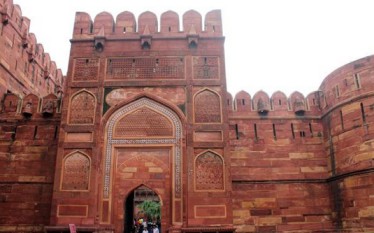
Though it was only during the reign of ‘Shah Jahan’, the grandson of Akbar, the site took on how it is currently. Unlike his grandfather, Shah Jahan tended to have buildings made completely of white marble for which he destroyed few buildings inside the fort so that he could make of his own.
It is rumoured that during the last few years of his life, he was deposed by his own son ‘Aurangzeb’ in the fort itself. It rumoured that Shah Jahan died in ‘Muasammam Burj’, a tower with a marble balcony with a view of Taj Mahal which he built in the memory of his wife, ‘Mumtaz Mahal’.
The fort was later under ‘Jat’ rulers of Bharatpur for 13 long years and they even built ‘Ratan Singh ki Haveli’ inside the fort.
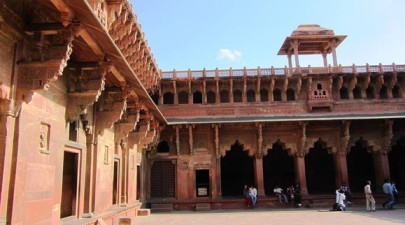
The fort was then invaded and captured by the ‘Maratha Empire’ in the early 18th century. After their defeat at the ‘Third Battle of Panipat’ by ‘Ahmed Shah Abdali’ in 1761, Marathas remained out of the region for the next whole decade.
Finally, ‘Mahadji Shinde’ took over the fort in 1785. It was then lost by the Marathas to the Britishers during the ‘Second Anglo-Maratha War’ in 1803.
The fort was even a site of battle during the ‘Indian Rebellion of 1857’ which led to the end of ‘British East India Company’s’ rule in India and a century of direct rule of India by Britain.
Layout of Agra Fort
A semicircular plan, the fort is 380,000 square metres and its chord lies parallel to the river Yamuna and the walls are 70 feet high.
Four gates are provided on its four sides with one ‘Khizri Gate’ opening on to the river. Two of the fort’s gates are notable: the ‘Delhi Gate’ and the ‘Lahore Gate’ which is also popularly called the ‘Amar Singh Gate’.

Delhi Gate was a masterpiece of that era and is the grandest of all the four gates. It is embellished with an intricate inlay work with white marble and it was used to enhance the security and also was used as King’s formal gate and interestingly has combined features.
As the Indian Military is still been using the northern portion of the fort, the Delhi gate cannot be used by the public. Tourists enter the fort only via the Amar Singh Gate.
Architectural History of Agra Fort
‘Abul Fazal’ recorded a whooping five hundred buildings in the beautiful designs inspired by Bengal and Gujarat which were built in the fort.
Some of them were demolished by Shah Jahan as he wanted to build his white marble palaces while others were destroyed by the British troops of East India Company between 1803 and 1862 for raising barracks.
Hardly 30 buildings have made its way on the south-eastern side, facing the holy river, such as the Delhi Gate, Akbar Gate and a palace – ‘Bengali Mahal’.
The Bengali Mahal is built of red sandstone and is split into two – ‘Akbari Mahal’ and ‘Jahangiri Mahal’.
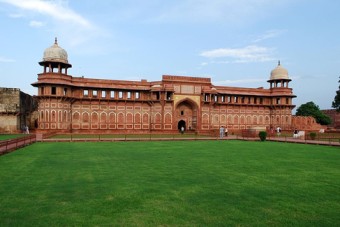
Historic Sites inside the Agra Fort
Jahangir’s Hauz – A.D. 1610: A monolithic tank, this was for bathing purpose. It is 5 feet high, 8 feet in diameter and 25 feet in circumference. On the external side of the rim, there is a Persian inscription which reads ‘Hauz-e-Jahangir’. Its due to this Hauz, the palace became as Jahangiri Mahal though it is part of Akbar’s Bengali Mahal.
Shahjahani Mahal – 1628-35 A.D.: Situated between the white marble ‘Khas Mahal’ and the red stone ‘Jahangiri Mahal’ and is set between complexes of two different ages. It has a large room, side rooms and an octagonal tower on the river side. It has brick and red stone all redone with a thick white stucco plaster and painted colourfully with floral designs. On the front, it has a spacious marble clan which has five arches and are supported by double pillars and externally protected by a ‘chhajja’.
Ghaznin Gate – 1030 A.D.: The gate has been made of local deodar wood of Ghazni. There is also an Arabic inscription carved at the upper part, mentioning Mahmud with epithets. ‘Sir John Marshall’ had placed here a notice-board which explains the whole story behind this gate. It is 16.5 feet high and 13.5 feet broad weighing half a ton.
Jahangir’s Chain of Justice – 1605 A.D.: Mughal King Jahangir instituted his ‘chain of justice’ (Zanjir-i-Adl). It was 80’ in length and had around 60 bells and weighed 1 quintal made with pure gold. One end was fastened to the battlements of the Shah-Burj and another end to the stone post on the bank of the river. Many considered it as a myth but it was depicted in a contemporary painting made in 1620 A.D.
The Muthammam Burj & Jharokha – 1632-1640 A.D.: This beautiful place surmounts on the river side facing the east. Built originally of red stone by Akbar, he used it for ‘Jharokha darshan’ as well as for worshipping the sun. Shah Jahan too used it for Jharokha darshan. It is an octagonal building with five external sides overlooking the river. The Burj offers full and majestic view of the beautiful Taj Mahal.
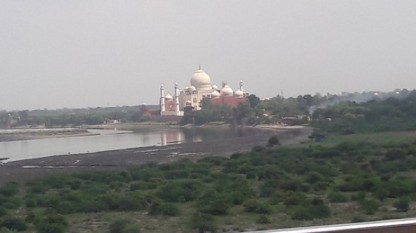
Shish Mahal A.D. 1631-40 – It was built by Shah Jahan as a part of the summer palace. The most distinctive feature is the glass mosaic work done on the walls and the ceiling. These glass pieces have a high mirror quality which glittered and sparkled in many ways even in a semi-dark interior.
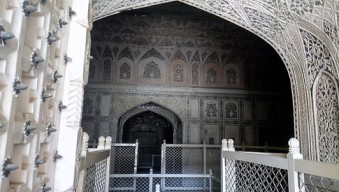
Things to do (Agra Fort)
The Agra fort is a huge fort considering the fact that each nook and corner needs special attention due to its significant history and rich culture.
Entry Fee: INR 35 (Indians); INR 550 (Foreigners); Free for children below the age of 15 years
Timings: 06:00 AM to 06:00 PM
How to reach Agra Fort?
The Agra Railway Station situated in Mantola is the nearest railway station which is around 2 km from Agra Fort.
Idgah Bus stand is only 4 km from Agra Fort.
Also, the inter-city connectivity makes the fort accessible from any part of the city.




